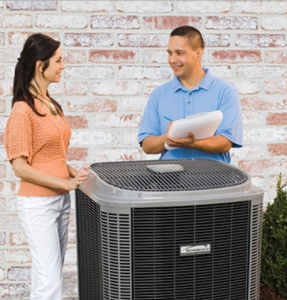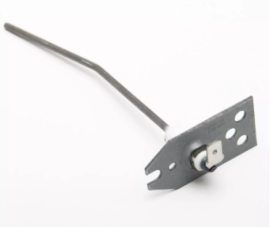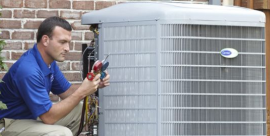Should I replace my gas furnace with an electric heat pump?


Now could be the perfect time to replace your gas furnace with an electric heat pump. Provisions in the 2022 Inflation Reduction Act aim to make it easy and affordable for low- and moderate-income households to convert their gas furnace to an electric heat pump. You may be able to get up to an $8,000 instant rebate for a new electric heat pump to replace a gas furnace in 2023. You could also get up to $6,500 additional instant rebates to help you revise your home’s electrical box and wiring to accommodate the new heat pump.
How do I get a rebate for replacing my gas furnace with an electric heat pump?
Specific details of electric heat pump rebates are still being worked out by the specific state governments that will administer the program. Bookmark this page and check back for updates.
Here’s current, general information about the heat pump rebate provided by the 2022 Inflation Reduction Act.
Income requirement for the heat pump rebate in the 2022 Inflation Reduction Act
Households earning less than 150% of their area’s median income will qualify for an electric heat pump rebate up to $8,000 when replacing a gas furnace.
Low-income households will be able to receive a 100% rebate up to $8,000 for replacing a gas furnace with an electric heat pump. A low income household is defined by the 2022 Inflation Reduction Act as a family that makes less than 80% of their area’s median income. To get an idea of your area’s median income, use the Fannie Mae Area Median Income Lookup Tool. For example, in the Dallas, Texas area where median annual income is $96,500, a household making less than $76,480 (80% of $96,500) will qualify for the 100% up to $8,000 on a new electric heat pump when replacing a gas furnace.
Moderate-income households that earn between 80% and 150% of their areas median income ($76,480 - $144,750 for the above example) qualify for a 50% rebate up to $8,000 for a new electric heat pump when replacing a gas furnace.
Heat pump rebates are projected to be available in some states as early as March of 2023.
When you’re ready to replace your gas furnace with an electric heat pump, schedule a free consultation with a Sears Home Services heating and cooling expert to begin the process and learn about rebates available in your area.
Income requirement for the electric system revision rebates in the 2022 Inflation Reduction Act
Income qualifications for electric system revision rebates are the same as heat pump rebates provided by the 2022 Inflation Reduction Act.
Low-income households qualify for 100% rebates on electrical system revisions for replacing a gas furnace with an electric heat pump.
Moderate-income households can get 50% rebates for electrical system revisions for installing an electric heat pump to replace a gas furnace.
Electrical system work that qualifies for Inflation Reduction Act rebates includes circuit breaker box and home wiring revisions.
Up to $4,000 for circuit breaker box revisions.
Up to $2,500 for home wiring revisions.
The total amount of Inflation Reduction Act rebates for an electrification project can’t exceed $14,000.
Electrical system revision rebates should be ready at the same time as electric heat pump rebates. Check back for updates on the availability of Inflation Reduction Act rebates coming in 2023.
Frequently asked questions about 2022 Inflation Reduction Act rebates for replacing a gas furnace with an electric heat pump
Here are answers to common questions about rebates available for replacing your gas furnace with an electric heat pump.
Why is an electric heat pump better than a gas furnace?
Using an electric heat pump instead of a gas furnace will help reduce carbon emissions. Heat pumps typically cut the carbon footprint of your HVAC system in half.
Typically, you can save more than $400 per year on energy bills by replacing a gas furnace with a heat pump. A heat pump is more energy efficient than a gas furnace because it uses expansion properties of refrigerant to heat your home instead of burning fuel to heat air.
Because there’s no combustion involved in heat pump operation, the unit is inherently safer than a gas furnace. Although built-in safeguards in furnaces help keep the risk of fire and carbon monoxide poisoning low, safety devices aren’t fool-proof. Gas furnace accidents still happen.
According to the National Fire Protection Association, “heating equipment is a leading cause of fires in U.S. homes.” About 12 percent of heating equipment fires are caused by central heat systems.
You can reduce the risk of accidents by replacing your gas furnace with a heat pump.
Why does my house electrical system need revisions to replace my gas furnace with an electric heat pump?
Home electrical systems vary so revisions required for installing an electrical heat pump to replace a gas furnace will depend on the existing wiring and breaker box in your home and the type of furnace that you currently have installed.
In homes that use just a furnace without a central air conditioner, an electrician will likely need to install new wiring circuits and breakers to power an outside condensing unit for the new heat pump. Some electric heat pump systems may need additional 240-volt circuits added to power electrical components. Wiring to some parts of the HVAC system may need to be upgraded to power the electrical heat pump.
The rebates for home electrical system revisions are aimed at covering the cost of overcoming these challenges for low- and moderate-income households when switching from a gas furnace to an electric heat pump.
How does a heat pump work?
Contrary to its name, a heat pump doesn’t really pump any heat—it moves refrigerant to heat and cool your home.
The compressor acts similar to a pump. It compresses refrigerant. The refrigerant heats up when it’s compressed.
In winter, the heat pump system moves hot refrigerant through the evaporator in the inside unit of your home. A blower fan circulates air inside your home through the hot evaporator to heat your home.
In summer, the same refrigerant cools your home. The compressor compresses refrigerant and sends the hot refrigerant through the outside condenser unit to cool down the refrigerant. The cooled down refrigerant travels to the inside unit in your home. The refrigerant passes through an orifice to make a fine mist that enters the evaporator. The refrigerant mist absorbs heat from the evaporator and cools the air circulated through the cold evaporator by the blower fan.
How long does a heat pump last?
With proper care and maintenance, a modern heat pump can last 20 years or more. The average lifespan is about 15 years.
To keep the heat pump in top shape and lasting longer, schedule yearly maintenance by a Sears Technician.
During the HVAC maintenance, the technician will:
Check your control thermostat settings and review the settings with you.
Check the air filter.
Check electrical connections.
Make sure the system controls and safety circuits work properly.
Lubricate the blower motor, if necessary.
Check the condenser coil and clean it, if needed.
Make sure the condensate pump works properly, if applicable.
Check and clean the condensate drain line.
Check the evaporator for adequate air flow.
You’ll keep your home comfortable all year long and reduce the risk of unexpected breakdowns when you have your HVAC system regularly serviced by a Sears Technician.
Most common symptoms to help you fix your heating & cooling combined units
Choose a symptom to see related heating and air conditioning system repairs.
Thermostat problem, clogged air filter, burner failure…
Dirty air filter, clogged condenser coils, low refrigerant charge, faulty compressor…
Thermostat problems, bad compressor/condenser fan capacitor, lack of refrigerant, failed compressor…
Main causes: errant thermostat settings, lack of electrical power, clogged drain line, wiring failure, control failure.…
Main causes: Errant thermostat settings, lack of power, bad interlock switches, lack of exhaust ventilation, wiring fail…
Dirty flame sensor, failed flame sensor, damaged burner, bad high limit switch…
Most common repair guides to help fix your heating & cooling combined units
These step-by-step repair guides will help you safely fix what’s broken on your HVAC system.

How to unclog the air conditioner drain line
The condensate drain line for your central air conditioner can clog with mold and mildew. Water will back up and start d…

How to replace the furnace flame sensor
The flame sensor detects when furnace burner flames are lit. You may need to replace the flame sensor if flames only sta…

How to replace a heating and air conditioning system thermostat
The control thermostat for your HVAC system can stop working. This repair guide shows how to replace it.…
Effective articles & videos to help repair your heating & cooling combined units
Use the advice and tips in these articles and videos to get the most out of your HVAC system.

Learn how to maintain your central air conditioner to keep it running smoothly all summer long.…

Learn about all the convenient features on our Sears PartsDirect website that make your parts purchases easier.…

Get answers to frequently asked questions about Sears and Sears PartsDirect.…